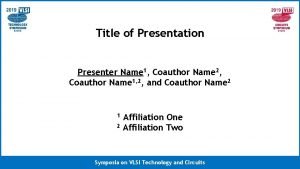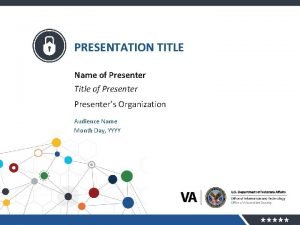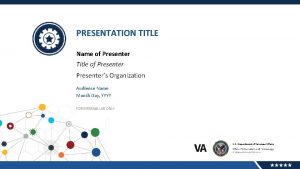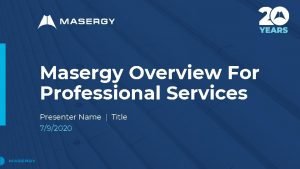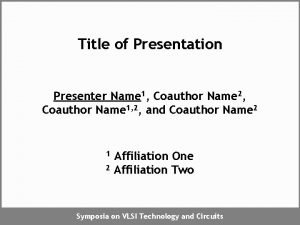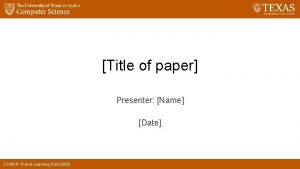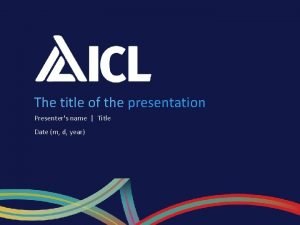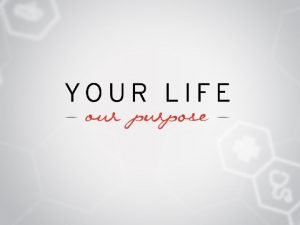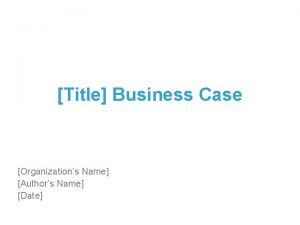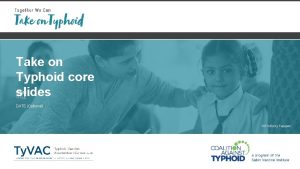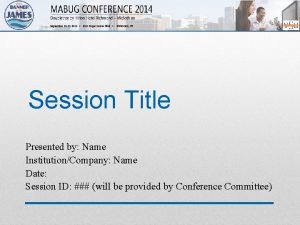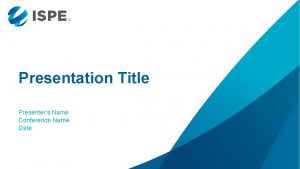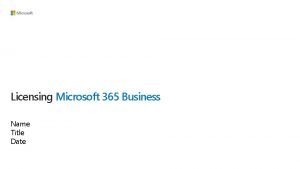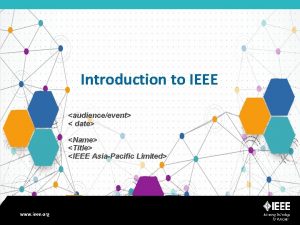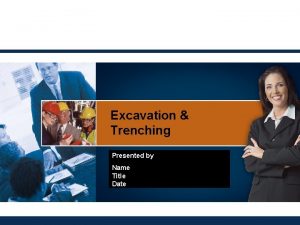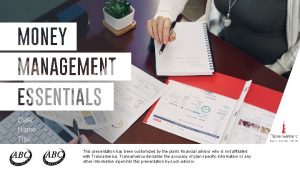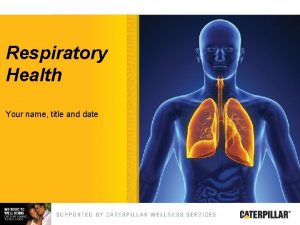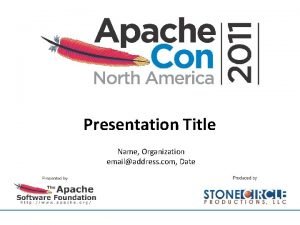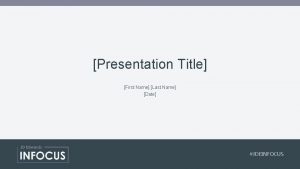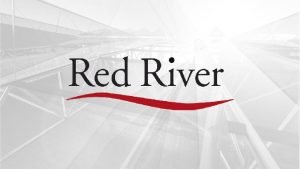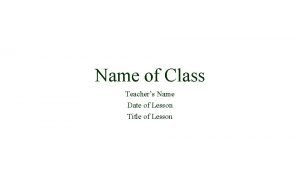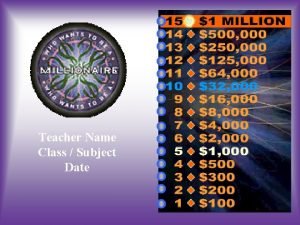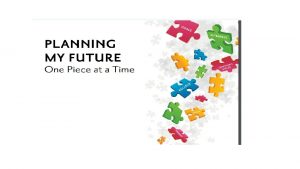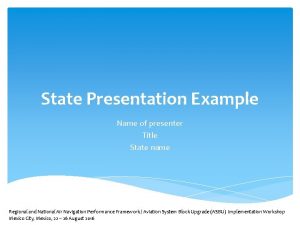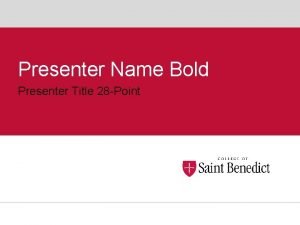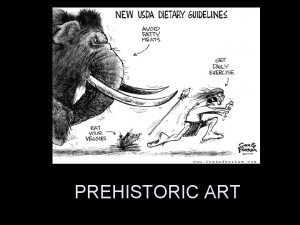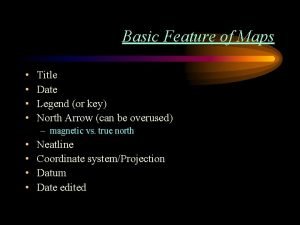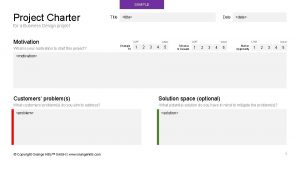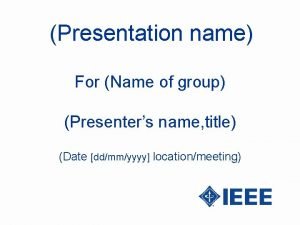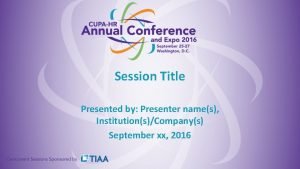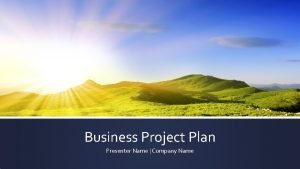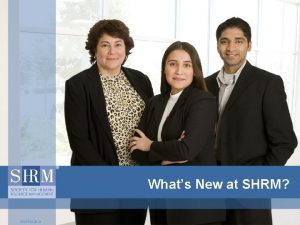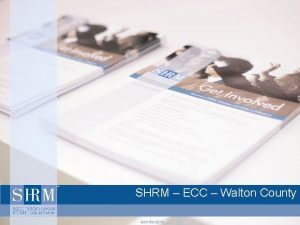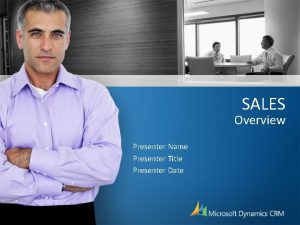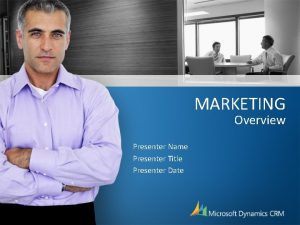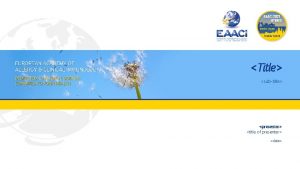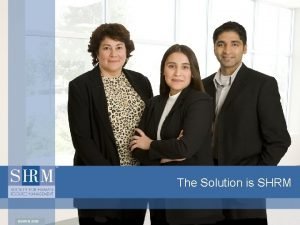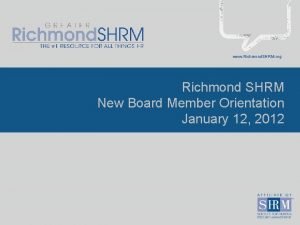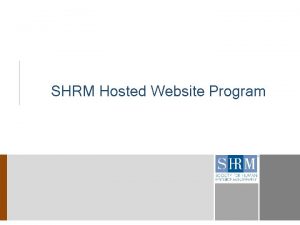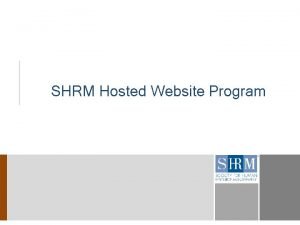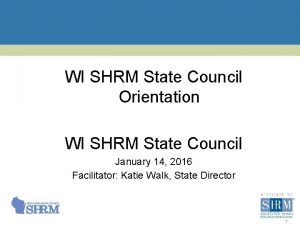Presenter Name Presenter Title Date 2019 SHRM All





![[Inclusion Captain’s Employer] © 2019 SHRM. All Rights Reserved [SHRM Foundation Inclusion Captain (logo)] [Inclusion Captain’s Employer] © 2019 SHRM. All Rights Reserved [SHRM Foundation Inclusion Captain (logo)]](https://slidetodoc.com/presentation_image_h/a6ed38ef87e1ae81f222e419fc738bc6/image-6.jpg)




































- Slides: 42

Presenter Name | Presenter Title Date

© 2019 SHRM. All Rights Reserved 2 2

Professionalism/work ethic Work ethic/discipline Teamwork/collaboration Teamwork Leadership and management Communicating effectively Mental toughness Critical thinking/problem solving Adapting to different challenges Ethics/social responsibility Professionalism Note: Adapted from Work After Service: Developing Workforce Readiness and Veteran Talent for the Future, by D. A. Bradbard, N. A. Armstrong, and R. Maury retrieved from ivmf. syracuse. edu/wpcontent/uploads/2016/05/WORK-AFTER-SERVICE-Developing-Workforce-Readiness-and-Veteran-Talent-for-the-Future. pdf. Copyright 2016 by the Institute for Veterans and Military Families, Syracuse University. © 2019 SHRM. All Rights Reserved 3 3

Once employed, nearly half of veterans left their first post-separation position in the first year and more than 65% left their first job within two years. (7) © 2019 SHRM. All Rights Reserved 4 4

© 2019 SHRM. All Rights Reserved 5 5
![Inclusion Captains Employer 2019 SHRM All Rights Reserved SHRM Foundation Inclusion Captain logo [Inclusion Captain’s Employer] © 2019 SHRM. All Rights Reserved [SHRM Foundation Inclusion Captain (logo)]](https://slidetodoc.com/presentation_image_h/a6ed38ef87e1ae81f222e419fc738bc6/image-6.jpg)
[Inclusion Captain’s Employer] © 2019 SHRM. All Rights Reserved [SHRM Foundation Inclusion Captain (logo)] © 2019 SHRM. All Rights Reserved 6 6

© 2019 SHRM. All Rights Reserved 7 7

© 2019 SHRM. All Rights Reserved 8 8

Veterans have unique skills, knowledge and abilities (SKAs). Your organizational needs are aligned with their SKAs. Companies generally gain enormous goodwill from customers and a boost in their public image when they commit to hiring more military veterans. (8) Veteran’s competencies align with your corporate values. You want to demonstrate appreciation for their service to the nation. Companies can earn up to $10, 000 in federal and state tax credits through the Work Opportunity Tax Credit (WOTC). (9) © 2019 SHRM. All Rights Reserved 9 9

Your company is recognized as a militaryfriendly organization. © 2019 SHRM. All Rights Reserved Your company’s brand reinforces its vision, mission and values. Your organizational culture is inclusive. © 2019 SHRM. All Rights Reserved Your position responsibilities have a clear purpose and align with your organization’s goals. 10 10

Workforce readiness is a combination of what the veteran brings to the workplace and what the employer does to align with the needs of its veteran employees. There is a relationship between job preferences, military-conferred skills, and a variety of outcome measures, including retention, income, and perceptions about transition. The application of the skills gained in the military and securing employment in a desired career field are two critical factors in the transition process for both veterans and their employers. Is this job in your preferred career field? Skills Knowledge of Military skills Abilities Workforce development Knowledge Other workplace supports Did this job match the occupations you were trained for in the military? Did your veteran or military status help you obtain your current post-military job? Note: Adapted from Workforce Readiness Alignment: The Relationship Between Job Preferences, Retention and Earnings (Workforce Readiness Briefs, Paper No. 3) by R. Maury, B. Stone, D. A. Bradbard, N. Armstrong, and J. M. Haynie retrieved from ivmf. Syracuse. edu/wp-content/uploads/2017/10/WORKFORCE-READINESS-ALIGNMENT. pdf. Copyright 2016 by the Institute for Veterans and Military Families, Syracuse University (10) © 2019 SHRM. All Rights Reserved 11 11

Meet with leaders/hiring managers and walk them through the importance of readiness workforce alignment and how it serves as the foundation to the workforce and employment initiatives like the veteran employment program. Champion and provide advocacy and outward support for workforce readiness alignment and balance of your workforce in all employment programs. Develop close working relationships with talent placement agencies. Footer © 2019 SHRM. All Rights Reserved 12 12

Ensure leadership at all levels understands the business case for hiring veterans and how it supports employer readiness. Be willing to support, champion and provide advocacy for the veteran employment program. Create one designated point of contact for federal, state and non-profit military organizations that can funnel military candidates. (11) Ensure company website appeals to Veteran talent: • Images and icons denoting military inclusiveness • A page devoted to content addressing the military-connected job seeker • Information about benefits programs, employee resource groups and activities that signal ongoing engagement after hire • Job descriptions and skills laid out in an easy-to-follow grid that correlates military occupational codes (MOCs) to organizational skills, making it quick and easy for job seekers to identify which opportunities are the best fit for them. (12) © 2019 SHRM. All Rights Reserved 13 13

Workforce alignment Recognized military-friendly organization Demonstrated appreciation for service to the nation Footer © 2019 SHRM. All Rights Reserved 14 14

You want to develop a strategic process that will attract and recruit the best talent available to ensure your organization has the right people, with the right skills, who are in the right job, and are working against the right requirements. (16) Transform your hiring needs from “as-needed” to proactive © 2019 SHRM. All Rights Reserved Develop candidate pipelines Create diversity © 2019 SHRM. All Rights Reserved Employ people who have the ability to grow 15 15

Will the candidate be a good cultural fit and deliver an ROI? © 2019 SHRM. All Rights Reserved Who should be targeted? How can the targeted candidates best be reached? © 2019 SHRM. All Rights Reserved What skills and competencies are needed to compliment the current workforce? How are we building relationships with candidates and current staff? 16 16

© 2019 SHRM. All Rights Reserved 17 17

Provides insight to how the candidate acted in specific employment-related situations. The logic is past performance predicts future performance. © 2019 SHRM. All Rights Reserved Looks at things from a forward-thinking perspective, giving the candidate the opportunity to highlight their analytical and problem-solving skills, and how they would work under pressure. © 2019 SHRM. All Rights Reserved 18 18

Be familiar with the MOCs that correlate with the job. At the start of the interview, thank military-talent applicants for their service or spouses for their support at home. Clearly describe the job role and its responsibilities, defining expectations upfront and avoiding generalizations. Draw out applicants and uncover their strengths by asking them to share their stories. Avoid closed-ended questions (those that elicit a "yes" or "no" response) by asking probing, job-related questions about an individual's service experience. Focus on actively listening for skill sets and correlate them with job functions within the organization. When interviewing military spouses, ask questions using a similar behavioral and situational approach. Members of this talent pool are often found to be great problem-solvers with an ability to manage change adeptly. (20) Footer © 2019 SHRM. All Rights Reserved 19 19

Cultivate an excellent candidate experience. Apply a resource endowment lens to human capital needs assessment - Look across the organization and apply a skills and competency inventory to identify both areas within the firm where existing skill and competencies are both superior and lacking. (21) Ensure that education level and years of direct experience are not being exclusionary. Review, update and confirm job descriptions and postings. © 2019 SHRM. All Rights Reserved 20 20

Conduct a "sanity” check on job descriptions, pass the job descriptions around to other departments to see if the roles and responsibilities are clear. Others may identify ways to add to the job posting that will help military candidates find the job to be more attractive. Connect with Veteran-focused employer hiring organizations: • • Employer Support of the Guard and Reserve (ESGR) Hire Our Heroes, United Services Organizations (USO) Wounded Warrior Project Local Veteran Services Organizations (VSO) Host Focus on Veterans’ needs and skills, in order to match them with the best positions in the company. Before looking at resumes, hiring managers remove three things: sex, race, and school name. This is to ensure that they are only looking at job qualifications and are accordingly placing veterans. (23) Let Veterans know you have received their resume or application and give them some insight as to the next steps in your application process. © 2019 SHRM. All Rights Reserved 21 21

Veteran Recruiters Relationship building Use of technology Footer © 2019 SHRM. All Rights Reserved 22 22

Use processes that allow new employees to learn about the organization, its structure, and its vision, mission and values, as well as to complete an initial new-hire orientation process. (25) Acclimate © 2019 SHRM. All Rights Reserved Engage © 2019 SHRM. All Rights Reserved Retain 23 23

• Discuss what the company expects from them • Detail the role they will play in achieving team or company goals • Manage expectations on what they can expect from the company – Management support – Availability of resources – Performance reviews. (26) • Build supportive relationships between a new employee and management • Emphasize company's commitment professional growth and talent recognition (26) • Increase retention rates • Decrease monetary costs (26) © 2019 SHRM. All Rights Reserved 24 24

Communicate before the first day, send a welcome letter to the new employee and family, lay out what they can expect in their first week. Have a role and responsibilities discussion Build 90 Day plan in first week. (27) Help your new employee build a social network Send hiring manager a “reminder alert” email requesting these five critical tasks are done on the first day. © 2019 SHRM. All Rights Reserved Match your new employee with a peer buddy Set up onboarding check-ins once a month for your new employee’s first six months Encourage open dialogue (27) © 2019 SHRM. All Rights Reserved 25 25

Send information about the company dress code in a welcome letter. Build in tangible goals and check-in points on their 90 -day plan. Send an introduction letter to the team, highlighting some of the assignments and places the Veteran has been. Be sure to let the team and leadership know what department the Veteran will be working in and the date of their first day on the job. Conduct a team introduction. © 2019 SHRM. All Rights Reserved Plan to have lunch as a team, at a minimum, have a one-on-one lunch with a team member. 26 26

Acclimate Engage Retain Footer © 2019 SHRM. All Rights Reserved 27 27

A set of integrated organizational HR processes designed to attract, develop, motivate, and retain productive, engaged employees throughout the employee lifecycle. High-performance © 2019 SHRM. All Rights Reserved Sustainable organization Obtain strategic and operational goals © 2019 SHRM. All Rights Reserved Meet objectives 28 28

Identify clear talent development vision, values, and goals that support your business objectives. Build an end-to-end talent development framework that serves as the programmatic roadmap for how you attract, build and retain talent. Administer a talent gap assessment that serves as the baseline of near term competencies and actions that need to occur to shore up immediate gaps and guide long-term talent investments. Implement an employee engagement program that measures perceptions of the workforce and provides data to leadership on the true pulse of the culture and the workforce. Commit to a diversity and inclusion strategy that promotes balanced hiring and development. Deliver an HR talent and tools assessment to assess if you have the internal capabilities to execute, maintain and measure against your talent management goals over time. (29) Create a talent succession plan model that defines the roles, responsibilities and demonstrated capabilities needed for advancement. © 2019 SHRM. All Rights Reserved 29 29

Secure C-suite buy in for your talent management strategy. © 2019 SHRM. All Rights Reserved Provide a standardize talent review and feedback processes. © 2019 SHRM. All Rights Reserved Increase visibility of talent management initiatives. 30 30

Explain policies and procedures in a transparent and proactive manner, while setting up informal checkpoints and feedback sessions in advance of formal evaluations. Be able to say what’s next: • Share opportunities for further development, training and certification. • Opportunities to expand, move, repurpose, or refocus as needed. Potential and readiness are not the same. Take the time to develop veterans to get the right mix of experience, skills and personal qualities to assume additional organizational responsibilities and leadership. Provide early, frequent and informal performance feedback. (31) Footer © 2019 SHRM. All Rights Reserved 31 31

Rotational experience Professional development (enlisted and officer) Footer © 2019 SHRM. All Rights Reserved 32 32

Is a dynamic internal process for moving talent from role to role – at the leadership, professional, and operational levels. This is also inclusive of offboarding or employee exit. (33) Shorter time to productivity Greater employee engagement & retention © 2019 SHRM. All Rights Reserved Lower talent acquisition costs Stream lined information flow © 2019 SHRM. All Rights Reserved Limited competitiveintelligence leakage Stronger leadership teams Better financial performance 33 33

Encourage multidirectional career moves Help managers identify high potentials, not just high performers © 2019 SHRM. All Rights Reserved Set clear goals Be transparent © 2019 SHRM. All Rights Reserved Settle on metrics that track back to goals Provide learning opportunities that make sense Make it a part of your culture (34) 34 34

Develop unstructured opportunities for employees to move to different locations on project basis early on, add value to the community and then come back. (35) Put in place an internal job market by using a common platform for both local and international opportunities. (35) Employees dedicate 20 percent of their time to side projects or testing waters with different roles. (36) Footer © 2019 SHRM. All Rights Reserved 35 35

Throughout the rotational process provide broad-based experience, but also assign the veteran specific tasks that are meaningfully related to the organization’s mission. Make explicit the connection between the veteran’s role on the team, and the positive impact they make on the organization. A collaborative approach to workforce development can also include making training and professional development for veterans a priority for the Local Workforce Investment Board (LWIB) and its network of Department of Labor (DOL) One Stop Career Centers. Foster personal development by integrating mentoring and coaching throughout the rotational assignments that provides valuable contacts and experience that accelerate the development of technical skills, awareness, and acclimation to the culture of the company. Consider how certifications and credentials obtained in the military can be relevant to credentialing requirements needed for professional development, including those specific to any departments participating in the rotation. (37) Footer © 2019 SHRM. All Rights Reserved 36 36

Greater employee engagement and retention Lower talent acquisition costs Footer © 2019 SHRM. All Rights Reserved 37 37

Are we poised and ready to effectively support Veteran employment? Are we attracting the right Veteran talent, with the right skills, at the right time to support the business requirements? Will our onboarding processes facilitate Veteran talent’s rapid and thorough integration into the existing workforce? Access the SHRM Foundation Digital Toolkit © 2019 SHRM. All Rights Reserved Do we have the right mix of integrated organizational HR processes to engage, develop and retain our veteran talent? Are we utilizing all levels of our current workforce to provide rational assignments in the business? Earn your Veterans at Work certificate 38 38

“The simple truth is that every Veteran has his or her own unique story, and there's no single narrative about the issue of Veterans finding civilian employment. And no single solution. “ Cathy Engelbert

© 2019 SHRM. All Rights Reserved 40 40

© 2019 SHRM. All Rights Reserved 41 41

© 2019 SHRM. All Rights Reserved 42 42
 Draw three noncollinear points j k and l
Draw three noncollinear points j k and l Presenter title
Presenter title Title of presenter
Title of presenter Presenter name
Presenter name Presenter
Presenter Name/title of presenter
Name/title of presenter Name/title of presenter
Name/title of presenter Name/title of presenter
Name/title of presenter Paper presenter
Paper presenter Name/title of presenter
Name/title of presenter Presenter title
Presenter title Presenter title
Presenter title By name title date
By name title date By name title date
By name title date Name title date
Name title date By name title date
By name title date Session name
Session name By name title date
By name title date Name title date
Name title date Name title date
Name title date By name title date
By name title date By name title date
By name title date By name title date
By name title date By name title date
By name title date Name title date
Name title date Emailadresses.com
Emailadresses.com Name title date
Name title date Itapseç
Itapseç Name teachers name class date
Name teachers name class date Name, class, subject
Name, class, subject Name date class teacher
Name date class teacher Record date ex dividend date
Record date ex dividend date What is ex dividend date
What is ex dividend date Presenter title
Presenter title Helvetica neue ltstd-cn
Helvetica neue ltstd-cn Lamp with ibex design
Lamp with ibex design Title date and legend are three
Title date and legend are three Project charter slide
Project charter slide Presenter name
Presenter name Nama group presentation
Nama group presentation Presentation name
Presentation name Name of the session
Name of the session Presenter company
Presenter company

